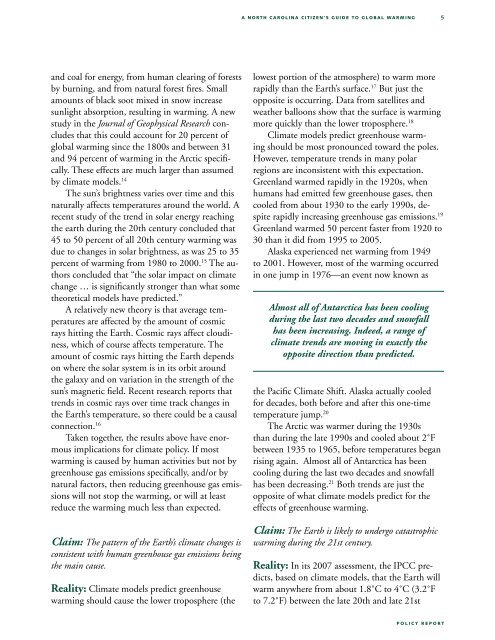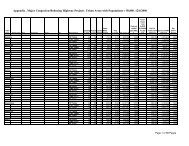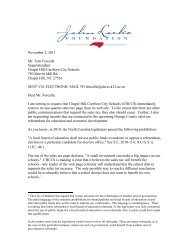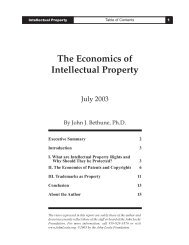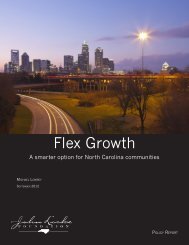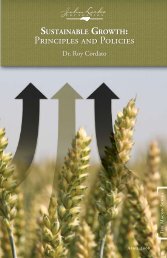A North Carolina Citizen's Guide to Global Warming - John Locke ...
A North Carolina Citizen's Guide to Global Warming - John Locke ...
A North Carolina Citizen's Guide to Global Warming - John Locke ...
You also want an ePaper? Increase the reach of your titles
YUMPU automatically turns print PDFs into web optimized ePapers that Google loves.
A N o r t h C a r o l i n a C i t i z e n ’ s G u i d e t o G l o b a l Wa r m i n g<br />
<br />
and coal for energy, from human clearing of forests<br />
by burning, and from natural forest fires. Small<br />
amounts of black soot mixed in snow increase<br />
sunlight absorption, resulting in warming. A new<br />
study in the Journal of Geophysical Research concludes<br />
that this could account for 20 percent of<br />
global warming since the 1800s and between 31<br />
and 94 percent of warming in the Arctic specifically.<br />
These effects are much larger than assumed<br />
by climate models. 14<br />
The sun’s brightness varies over time and this<br />
naturally affects temperatures around the world. A<br />
recent study of the trend in solar energy reaching<br />
the earth during the 20th century concluded that<br />
45 <strong>to</strong> 50 percent of all 20th century warming was<br />
due <strong>to</strong> changes in solar brightness, as was 25 <strong>to</strong> 35<br />
percent of warming from 1980 <strong>to</strong> 2000. 15 The authors<br />
concluded that “the solar impact on climate<br />
change … is significantly stronger than what some<br />
theoretical models have predicted.”<br />
A relatively new theory is that average temperatures<br />
are affected by the amount of cosmic<br />
rays hitting the Earth. Cosmic rays affect cloudiness,<br />
which of course affects temperature. The<br />
amount of cosmic rays hitting the Earth depends<br />
on where the solar system is in its orbit around<br />
the galaxy and on variation in the strength of the<br />
sun’s magnetic field. Recent research reports that<br />
trends in cosmic rays over time track changes in<br />
the Earth’s temperature, so there could be a causal<br />
connection. 16<br />
Taken <strong>to</strong>gether, the results above have enormous<br />
implications for climate policy. If most<br />
warming is caused by human activities but not by<br />
greenhouse gas emissions specifically, and/or by<br />
natural fac<strong>to</strong>rs, then reducing greenhouse gas emissions<br />
will not s<strong>to</strong>p the warming, or will at least<br />
reduce the warming much less than expected.<br />
Claim: The pattern of the Earth’s climate changes is<br />
consistent with human greenhouse gas emissions being<br />
the main cause.<br />
Reality: Climate models predict greenhouse<br />
warming should cause the lower troposphere (the<br />
lowest portion of the atmosphere) <strong>to</strong> warm more<br />
rapidly than the Earth’s surface. 17 But just the<br />
opposite is occurring. Data from satellites and<br />
weather balloons show that the surface is warming<br />
more quickly than the lower troposphere. 18<br />
Climate models predict greenhouse warming<br />
should be most pronounced <strong>to</strong>ward the poles.<br />
However, temperature trends in many polar<br />
regions are inconsistent with this expectation.<br />
Greenland warmed rapidly in the 1920s, when<br />
humans had emitted few greenhouse gases, then<br />
cooled from about 1930 <strong>to</strong> the early 1990s, despite<br />
rapidly increasing greenhouse gas emissions. 19<br />
Greenland warmed 50 percent faster from 1920 <strong>to</strong><br />
30 than it did from 1995 <strong>to</strong> 2005.<br />
Alaska experienced net warming from 1949<br />
<strong>to</strong> 2001. However, most of the warming occurred<br />
in one jump in 1976—an event now known as<br />
Almost all of Antarctica has been cooling<br />
during the last two decades and snowfall<br />
has been increasing. Indeed, a range of<br />
climate trends are moving in exactly the<br />
opposite direction than predicted.<br />
the Pacific Climate Shift. Alaska actually cooled<br />
for decades, both before and after this one-time<br />
temperature jump. 20<br />
The Arctic was warmer during the 1930s<br />
than during the late 1990s and cooled about 2˚F<br />
between 1935 <strong>to</strong> 1965, before temperatures began<br />
rising again. Almost all of Antarctica has been<br />
cooling during the last two decades and snowfall<br />
has been decreasing. 21 Both trends are just the<br />
opposite of what climate models predict for the<br />
effects of greenhouse warming.<br />
Claim: The Earth is likely <strong>to</strong> undergo catastrophic<br />
warming during the 21st century.<br />
Reality: In its 2007 assessment, the IPCC predicts,<br />
based on climate models, that the Earth will<br />
warm anywhere from about 1.8˚C <strong>to</strong> 4˚C (3.2˚F<br />
<strong>to</strong> 7.2˚F) between the late 20th and late 21st<br />
p o l i c y r e p o r t


